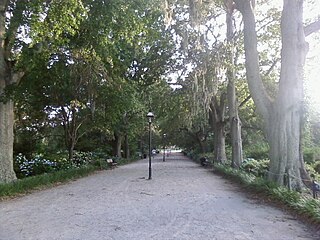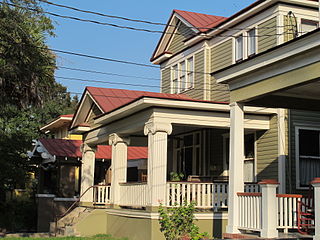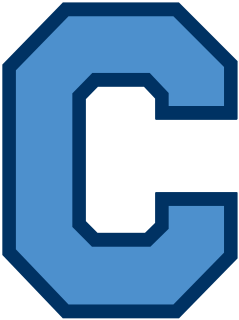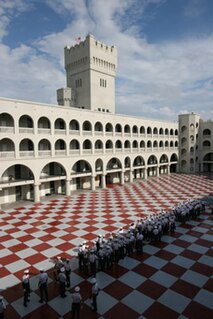
The Campus of The Citadel, The Military College of South Carolina consists of a 300-acre (120 ha) space adjacent to Hampton Park in Charleston, South Carolina. It has been home to The Citadel, The Military College of South Carolina since 1922 when the school moved from its location on Marion Square, including the Old Citadel. Arranged with the primary buildings surrounding a central 10-acre (4 ha) parade ground, it consists of barracks for the Corps of Cadets, academic buildings, a mess hall, chapel, library, athletic and recreational facilities, support buildings, and housing for faculty and staff.

Hampton Park is a public park located in peninsular Charleston, South Carolina, United States. At 60 acres (240,000 m2), it is the largest park on the peninsula. It is bordered by The Citadel to the west, Hampton Park Terrace to the south, North Central to the east, and Wagener Terrace to the north. The park is named in honor of Confederate General Wade Hampton III who, at the time of the Civil War, owned one of the largest collections of slaves in the South. After the Civil War, Hampton became a proponent of the Lost Cause movement, member of the Red Shirts and governor of South Carolina.

Charleston is the oldest and largest city in the U.S. state of South Carolina, the county seat of Charleston County, and the principal city in the Charleston–North Charleston–Summerville Metropolitan Statistical Area. The city lies just south of the geographical midpoint of South Carolina's coastline and is located on Charleston Harbor, an inlet of the Atlantic Ocean formed by the confluence of the Ashley, Cooper, and Wando rivers. Charleston had an estimated population of 134,875 in 2017. The estimated population of the Charleston metropolitan area, comprising Berkeley, Charleston, and Dorchester counties, was 761,155 residents in 2016, the third-largest in the state and the 78th-largest metropolitan statistical area in the United States.

The Citadel, The Military College of South Carolina, commonly referred to simply as The Citadel, is a state-supported, comprehensive college located in Charleston, South Carolina, United States. Established in 1842, it is one of six United States senior military colleges. It has 18 academic departments divided into five schools offering 29 majors and 38 minors. The military program is made up of cadets pursuing bachelor's degrees who live on campus. The non-military programs offer 10 residential undergraduate degrees, 24 residential graduate degrees, as well as online/distance programs with 7 online graduate degrees, 3 online undergraduate degrees and 3 certificate programs.
Contents
- Academic buildings
- Athletic and recreational buildings
- Administrative buildings
- Barracks
- Other buildings
- Monuments and memorials
- References
The campus is bounded on the west by the Ashley River, to the north by the Wagener Terrace neighborhood, to the east by Hampton Park and the Hampton Park Terrace neighborhood, and to the South by the Westside Neighborhood.

The Ashley River is a blackwater / tidal river in South Carolina, rising from the Wassamassaw and Great Cypress Swamps in western Berkeley County. It consolidates its main channel about five miles west of Summerville, widening into a tidal estuary just south of Fort Dorchester. The river then flows for approximately 17 miles along the historical banks of the City of North Charleston before reaching peninsular Charleston. The much wider Ashley joins the Cooper River off the Battery in Charleston to form Charleston Harbor before discharging into the Atlantic Ocean. At the present time the land around the Ashley River or in Ashley Barony, as the original land grant was called, is mostly undeveloped.

Hampton Park Terrace is the name both of a neighborhood and a National Register district located in peninsular Charleston, South Carolina. The neighborhood is bounded on the west by The Citadel, on the north by Hampton Park, on the east by Rutledge Ave., and on the south by Congress St. In addition, the one block of Parkwood Ave. south of Congress St. is considered, by some, to be included. The National Register district, on the other hand, is composed of the same area with two exceptions: (1) the northeasternmost block is excluded and (2) an extra block of President St. is included.
Just off the main campus are the football stadium, baseball stadium, and alumni center. Additionally, there is a large beach house facility located near the north end of the Isle of Palms. [1]

Isle of Palms is a city in Charleston County, South Carolina, United States. At the 2010 census, the population was 4,133. Isle of Palms is a barrier island on the South Carolina coast. The city is included within the Charleston-North Charleston-Summerville metropolitan area and the Charleston-North Charleston Urbanized Area. The town lies along a narrow strip of land, hugging the beach, separated from the mainland by the Intracoastal Waterway. It is an affluent community of both vacation home owners and year-round residents, with large beachfront homes, resorts, and local restaurants. Beach volleyball is popular in the summer, and the "Windjammer" club hosts several tournaments throughout the year.


























